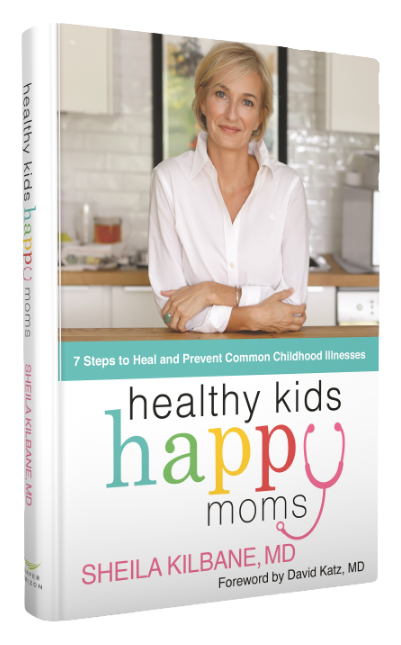Ear infections are the bane of modern parenthood, and Americans spend $4 billion each year treating them. Yet, despite their prevalence, these common infections are poorly understood and often over-treated.
During medical school and residency, I learned to treat ear infections with antibiotics but once I began practicing integrative medicine and incorporating nutritional recommendations into my daily pediatric practice, I found we were able to break the cycle of recurrent ear infections.
The Physiology Behind Ear Infections
Before we talk about the integrative approach, let’s review the physiology and anatomy that causes ear infections.
When babies are born, their eustachian tubes are, for all practical purposes, horizontal between the ear and the nose. As the baby grows, this begins to take on a more vertical angle. By the time the baby is two years old, the eustachian tube should be at its more adult-like vertical angle. This is part of the reason why adults have fewer ear infections than children; anatomy is on our side.

This illustrates the angle of an older child/adult ear. The eustachian tube is nearly vertical, which helps prevent fluids from backing up and becoming infected.
When the eustachian tube is not draining properly, it is called eustachian tube dysfunction. Viruses and bacteria often lead to ear infections. The virus or bacteria causes an increase in mucus, which eventually clogs the eustachian tube, leading to the buildup of fluid. The nasal mucosa and the sinus cavities can absorb (or resorb) fluid that has collected in the middle ear but there is a limit to this ability. A clogged middle ear is similar to a warm bathtub that is allowed to sit un-drained for several days, quickly becoming a cesspool teeming with bacteria.
Preventing Ear Infections
When a child has a chronic runny nose, allergies, or systemic inflammation, the stage is set for the poor drainage of the eustachian tube fluid to the back of the nose and throat. In truth, systemic inflammation is also the most common cause of chronic runny noses and allergies, so we need a deeper understanding of how to keep it in check.
Here’s an explanation of the role that inflammation plays in our health, taken from my book and online course.
Once you understand systemic inflammation, you can reduce all manner of childhood illnesses, including ear infections.
To understand systemic inflammation, this analogy might help. Think of the cup as the body, and the water as inflammation in the body. You’ll see that the level of inflammation is triggered from five main sources—food, environmental allergies, environmental toxins, infectious diseases and stress.
The glass on the right illustrates that our bodies have a baseline level of inflammation. Notice that the glass to the left is filled to the brim with systemic inflammation.
Illustrating the analogy of inflammation as a glass of water where the glass represents the body and the liquid represents inflammation level.
Excess inflammation leads to worsening symptoms. When we minimize inflammation, we minimize symptoms.
Ear Infection Case Study from my Practice
I had been seeing Levi to support him with an integrative approach to behavior challenges, anxiety, meltdowns, and eczema. During one visit I discovered he happened to have an ear infection but was not experiencing any ear pain or other symptoms.
Together with his mom, we explore his story in the video below:
Dr. Kilbane, her patient Levi, and his mother talk about the progress he has made on the Healthy Kids, Happy Moms program
Since Levi was generally healthy and not an infant, I felt it was safe to watch his ear infection to see if it would go away on its own. We continued to do all of the good integrative things we had already implemented, including his food and supplements.
He came back five days later so I could re-check his ear, and his eardrum was back to normal. The infection was resolved without the use of antibiotics and the rest of his issues are improving significantly with the integrative approach.
Antibiotics do not kill viruses. It is up to our own body’s immune system to take care of viral infections.
Upwards of 65% of ear infections will heal on their own, without the aid of an antibiotic. It is safe to watch and wait in certain scenarios depending upon the age of the child, their overall health status, the structure of their ear anatomy, and their past medical history. The American Academy of Pediatrics (AAP) calls this the watch and wait approach. Here are the full AAP guidelines.
Levi’s case illustrates how reducing systemic inflammation can make a difference in resolving all manner of illnesses, including ear and sinus infections.
Take the First Steps to Prevent Ear Infections
If you’re wondering where to start your family’s journey toward lowering inflammation, consider the Mini-Cleanse for kids, my time-tested method for decreasing the junk and making room for good, healthy nutrient-dense food in your child’s diet.
My online course and Healthy Kids, Happy Moms book will help you understand the integrative approach to cellular health. My supplement guide explains which supplements are most helpful and how to begin using them with a child. I have set aside time for limited private consultations at my private practice, Infinite Health.
References:
- Bahna SI, Myer CM. Food Allergy for the Pediatrician. Integrative Pediatrics 1988;3:245-9.
- Bock SA, May CD. Adverse reactions to food caused by sensitivity. In: Middleton EM, Reed CE, Ellis EF, eds. Allergy principles and practice. St. Louis, MO: CV Mosby, 1988;1415-27.
- Kettelhut BV, Metcalfe DD, Adverse reactions to foods. In: Middleton EM, Reed CE, Ellis EF, eds. Allergy principles and practices, St Louis, MO: CV Mosby, 1988:1481-502.
- Nsouli TM, Nsouli SM, Linde RE, O’Mara F, Scanlon RT, Bellanti JA. Role of food allergy in serous otitis media. Ann Allergy. 1994 Sep;73(3):215-9. PMID: 8092554.








